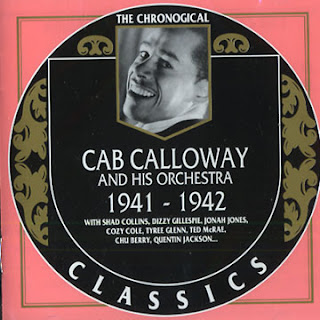Gene Krupa, his Orchestra and Anita O’Day featuring Roy Eldridge
Despite the wordy title, the main feature on this double LP is vocalist Anita O'Day (1919-2006). Trumpeter Roy Eldridge (1911-1989) is stunning in his solo spots but they are short statements. "The Walls Keep Talking" is one of the few tunes where he gets an extended solo. Since these twenty tracks were the pop commercial numbers, drummer and bandleader Gene Krupa (1909-1973) stays mostly in the background save a few fills and brief solo spots here and there. O'Day shines on each tracks, singing wonderfully while popularizing and helping push forward a new style of jazz singing and interpretation.
This compilation features tracks recorded between 1941 and 1945 with a healthy dose of material from 1941 when the front line of O'Day and Eldridge with the Krupa Orchestra made a big splash. Their biggest hit "Let Me Off Uptown" is here and is a brilliant showcase for them. O'Day does not sound at all like any of the other female vocalists of the big band era. In The Swing Era, Gunther Schuller states that rather than viewing singing as "interpretation of a lyric", it was a "quasi-instrumental creative expression, in which words and text would become secondary and indeed at times would be eliminated altogether". She freely improvises the melodies by varying or emphasizing every device available to the vocalist, including notes, rhythms, diction, tone, volume, held vs. short notes, ends of consonants, phrasing, etc. etc. She is also consistent in style from ballads to uptempo and from the wordless to the wordy.
The three recognizable tunes are definitive highlights: "Georgia On My Mind" is from April 11, 1941 even at this early date her back phrasing provides a personal interpretation of the melody that at times sounds remarkably like Billie Holiday. On "Skylark", from November 25, 1941, she takes daring changes with rhythm on this challenging melody, singing the A section differently each time. By 1945, her identity and tone is firmly established and she sounds more familiar. She sings two choruses on "Tea for Two" from October 1945 and is freely improvising throughout---the differences between the two choruses are astonishing and sounds like she'd keep re-interpreting the melody had she sung a third chorus. Her performance of the same tune at the Newport Jazz Festival in 1958 is unsurpassed, but back in 1945, she still owns the tune.
"Opus #1" is also from 1945 and, to my surprise, actually has lyrics. Written by Sy Oliver, it's a terrific chart and O'Day's performance is energetic and the band comes roaring back in sounding inspired after her chorus. Occasionally, on these later tracks Buddy Stewart will sing, but he is limited to commercial ballads. Krupa had recorded some bop tracks with Stewart singing together with Dave Lambert. Unfortunately we don't hear that here. Instead, his sleep chorus open "That Feeling in the Moonlight" and contrasts with O'Day's style as the tune goes to double time to feature her. "Boogie Blues" is the only blues track on the album and the synergy between O'Day and Eldridge is obvious here.
Except for a handful of tunes, most of the material here is forgettable, silly, and hopelessly dated. Singers were considered secondary to the band (just about all of the tracks feature the band playing the melody first) and tended to sing commercial pop songs. It contributed to the band's success and helped better translate O'Day's new style to the general public, Together with Eldridge's exciting upper-register solos, songs like "Chickery Chick" and "Just a Little Bit South of North Carolina" are greatly enhanced.
Her main influence was Billie Holiday and it is clear from the earliest tracks. The medium swing "Just a Little Bit of South of North Carolina" and the aptly titled "Slow Down" were from her first recording session from March-April 1941 and she is already unlike most big band singers. Particularly when she sings high, she'll vary the timbre of her voice for different effects. She is in control of her voice and is comfortable in both settings.
Roy Eldridge is a powerful presence on these tracks. Like O'Day, his role as the star soloist is clearly defined. He takes his cues from Louis Armstrong, but transposes everything to the upper register. That famous Armstrong vibrato at the ends of phrases is here but Eldridge's approach is even more extroverted and lusty. He likes to bend his phrases and more so than other players is not afraid to hit those quarter tones and other notes outside of the equal-tempered scales that our Western ears have been trained to accept as standard. It only highlights his identification with the blues and positions him nicely against O'Day's own vocal feats.
I haven't said anything about Krupa but he is keeping the rhythm going during these tracks and is not really distinguishable save a few fills and his trademark "Sing Sing Sing" tom-tom beats. The band sounds amazing and the arrangements, especially those from 1945, are exciting and swinging. There are a few scattered tenor solos, but the ones by Charlie Ventura stand out. He has a tight, raucous sound that sounds closer to rhythm and blues, but he generates energy and sounds great.
Anita O'Day was a daring rebel. Despite wearing long pants when female singers in big bands were expected to look more feminine, her voice had strong sex appeal and she sounds more alluring and teasing than other big band singers, especially white ones. Even on silly tunes like "Chickery Chick" or "Stop, the Red Light's On", you can hear these qualities as she expresses a very subtle sexiness, perhaps as much as was tolerated in this days. She's probably not the first white singer in this way, but likely opened the door for others to do so.








Comments
Post a Comment